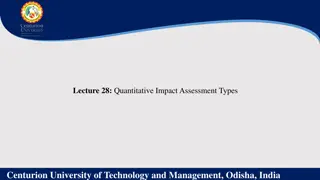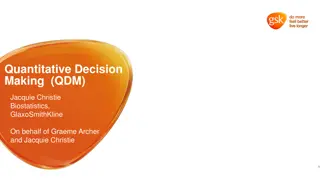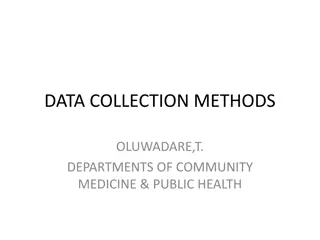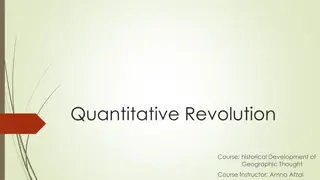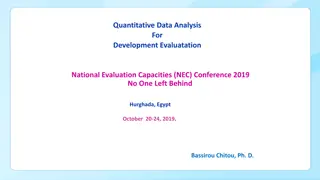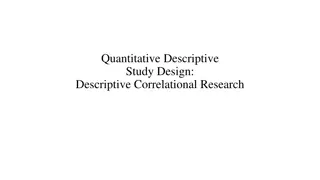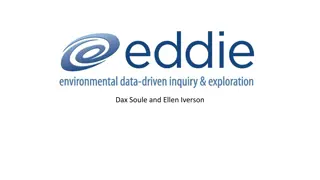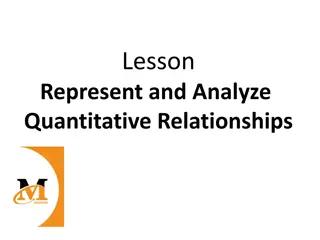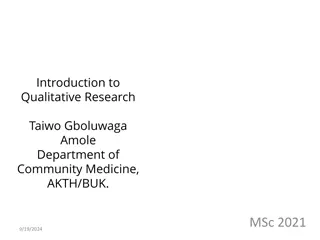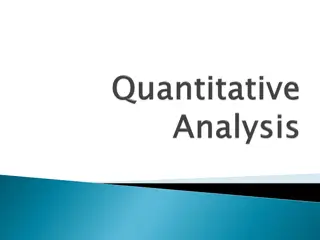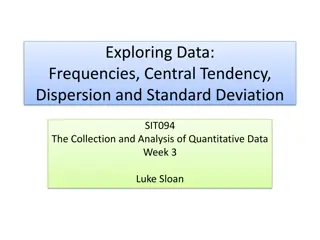Analyzing Qualitative and Quantitative Data
The findings from qualitative and quantitative data analysis. Learn how to apply analysis steps, compare platforms, and interpret results.
0 views • 33 slides
Understanding Quantitative Credit Control Methods in RBI's Monetary Policy
RBI's monetary policy revolves around maintaining credit quantity in the market through quantitative credit control methods. This includes Bank Rate Policy, Open Market Operations, Cash Reserve Ratio (CRR), and Statutory Liquidity Ratio (SLR). These tools help regulate credit flow, liquidity, and ma
4 views • 8 slides
A Primer for Designing Quantitative Research Studies
This primer introduces the processes involved in designing a quantitative study, focusing on conceptualization and design basics. It emphasizes the importance of training, coursework, and experience for conducting high-quality scholarly research. The content covers the purpose of the primer, variati
5 views • 29 slides
Understanding Quantitative Research Designs in Health Research
Quantitative research designs play a crucial role in health research, offering various methodologies like experimental and observational designs. Observational designs are commonly used and can establish associations but not causality. Longitudinal designs track outcomes over time, providing valuabl
3 views • 25 slides
Revolutionary Vitamin D Quantitative Rapid Test for Health Monitoring
SELOI HEALTHCARE PVT. LTD. offers a cutting-edge Vitamin D quantitative rapid test that provides instant results on smartphones, aiding in tracking markers and generating shareable reports within 30 seconds. With easy monitoring, multiple language support, and no setup costs, this innovative platfor
3 views • 9 slides
Overview of Research Process and Quantitative Research Phases
The research process involves steps like identifying, locating, assessing, and analyzing the research question to find answers. It includes quantitative and qualitative approaches, with specific phases like conceptual, design, empirical, analytic, and disseminating phases in quantitative research. E
9 views • 27 slides
Understanding Quantitative and Qualitative Research Methods
Exploring the differences between quantitative and qualitative research methods, this content delves into the importance of qualitative research, various methodologies such as focus groups and interviews, data collection, research ethics, and analysis techniques. It also covers the elements of the r
4 views • 43 slides
Understanding Quantitative Impact Assessment and Evaluation Methods
Quantitative impact assessments play a crucial role in measuring the effects of interventions or programs. Key types include output-based and outcome-based indicators, impact evaluations, cost-effectiveness analysis, econometric analysis, and the use of surveys and questionnaires. These methods help
0 views • 4 slides
Analyzing Two-Variable Data in Statistics and Probability
This content delves into analyzing relationships between two quantitative variables in statistics and probability, focusing on distinguishing between explanatory and response variables, creating scatterplots, and interpreting the strength and form of relationships displayed. It emphasizes the import
0 views • 14 slides
Understanding Boxplots and Identifying Outliers in Quantitative Data Analysis
Learn how to interpret boxplots, identify outliers using the 1.5 x IQR rule, and compare distributions of quantitative data. Explore examples like Barry Bonds' home run records and tablet thickness measurements to enhance your statistical analysis skills.
0 views • 21 slides
Unlocking the Power of Big Data in Teaching: Project EDDIE Workshop Insights
Delve into the impactful world of Project EDDIE, an initiative promoting data-driven inquiry in STEM education. Explore the benefits of teaching with big data, understand quantitative reasoning, and discover the objectives of EDDIE workshops. Experience the 5E model and enhance your approach to deve
0 views • 9 slides
Understanding Dotplots for Displaying Quantitative Data
Learn how to create and interpret dotplots for quantitative data visualization. This lesson covers making dotplots, describing distribution shapes, and comparing data sets. Explore the simplicity and effectiveness of dotplots in representing numerical information. Gain insights into analyzing dotplo
0 views • 14 slides
Understanding Quantitative Decision Making in Biostatistics
Quantitative Decision Making (QDM) in biostatistics enables optimal design of development plans and studies, quantifies decision risks, and minimizes bias. It involves setting targets and evidence levels, anchoring outcomes against targets, and establishing evidence thresholds for positive and negat
0 views • 27 slides
Understanding Data Collection Methods in Health Sciences
Data collection in health sciences involves gathering raw facts systematically to answer research questions and evaluate outcomes. This includes selecting appropriate methods based on the nature of the enquiry, availability of resources, and required precision. Quantitative data collection focuses o
0 views • 28 slides
Evolution of Geographic Thought: Quantitative Revolution
The Quantitative Revolution in Geography, led by Schaefer's critique of traditional views, propelled the shift towards a more objective and scientific approach. Embracing statistical and mathematical techniques, geographers sought regularities in spatial organization, marking a transition from areal
1 views • 11 slides
Project Risk Management Fundamentals: A Comprehensive Overview
Project risk management involves minimizing potential risks and maximizing opportunities through processes such as risk management planning, risk identification, qualitative and quantitative risk analysis, risk response planning, and risk monitoring and control. Quantitative risk analysis assesses t
0 views • 41 slides
Operations Planning and Control: Forecasting Methods Overview
Forecasting is a crucial process in operations management, involving the estimation of future events based on past and present information. This chapter covers the significance of forecasts, characteristics of forecasting, role in decision-making, various forecasting methods (qualitative and quantit
3 views • 74 slides
“Quantitative Data Analysis for Development - NEC Conference 2019 Overview”
Explore the key modules of the National Evaluation Capacities Conference 2019 focusing on quantitative data analysis for development. Covering topics such as basic concepts, summary statistics, bivariate analysis, hypothesis testing, data visualization, and the effective use of dummy tables in evalu
0 views • 25 slides
Quantitative Imaging and Dosimetry for Radiopharmaceutical Therapy Planning
This presentation highlights the importance of quantitative imaging and dosimetry in planning radiopharmaceutical therapy. It emphasizes the need for individualized dosimetry to tailor treatment procedures and verify the absorbed dose delivered. The content discusses the framework provided for treat
0 views • 34 slides
Introduction to Quantitative Reasoning using Spreadsheets
Explore the use of technology and modeling cycle in quantitative reasoning. Learn to read from spreadsheets, interpret data, analyze simple formulae and graphs, estimate quantities, and create mathematical models to solve real-world problems effectively. Leveraging resources and tools integral to ma
1 views • 38 slides
Contrasting Qualitative and Quantitative Traits in Genetics
Genetic traits in organisms can be qualitative or quantitative, with qualitative traits controlled by single genes and showing distinct variations, while quantitative traits are influenced by multiple genes and environmental factors, resulting in continuous variations. Qualitative genetics focuses o
0 views • 13 slides
Understanding Quantitative Research Design in Social Science
This content covers various aspects of quantitative research design, including descriptive and correlational studies, research design blueprint, robust research design considerations, and different types of research approaches. It emphasizes the characteristics, techniques, and terminologies associa
0 views • 24 slides
Understanding Histograms in Displaying Quantitative Data
Learn how to create and interpret histograms in displaying quantitative data. This lesson covers making histograms, interpreting distributions, and comparing data sets. Understand the importance of grouping data values and creating equal-width intervals for a clearer visualization. Explore the proce
10 views • 16 slides
Understanding Quantitative Analysis for Decision Making in Management
Quantitative analysis is a crucial scientific approach for managerial decision-making, involving data manipulation to derive valuable information. This method encompasses problem definition, model development, and acquiring input data. Mathematical models, variables, and parameters play key roles in
0 views • 11 slides
Qualitative vs. Quantitative Approaches in Health Research
Exploring the different methodologies, paradigms, and methods used in health research, this content highlights the distinction between qualitative and quantitative designs. It covers research questions, aims, objectives, hypotheses, and various quantitative approaches such as experimental and observ
1 views • 28 slides
Quantitative Study of Ecosystems: Techniques and Procedures
Exploring the study of ecosystems through quantitative methods like quadrat sampling and frequency analysis. Learn how to prepare, conduct fieldwork, and analyze data to understand the distribution of organisms in a selected ecosystem. This comprehensive guide covers learning objectives, safety meas
0 views • 24 slides
Understanding Research Methods: Quantitative, Qualitative, and Mixed Approaches
This introduction provides an overview of qualitative, quantitative, and mixed methods research, highlighting key differences and various types of research approaches. It delves into exploratory, descriptive, and causal research methodologies, offering insights into problem discovery, data collectio
0 views • 50 slides
Understanding Quantitative Genetics Principles in Animal Breeding
Quantitative genetics focuses on the inheritance of characteristics based on degree rather than kind, compared to qualitative genetics. It involves polygenes controlling quantitative traits, which exhibit continuous variation and can be measured using metric units. Qualitative traits, on the other h
0 views • 22 slides
Understanding the CAT4 Assessment and Reports
CAT4, the Cognitive Abilities Test Fourth Edition, assesses students' abilities in verbal, quantitative, non-verbal, and spatial reasoning. It distinguishes between ability and attainment testing and is used to identify academic potential, understand student thinking, determine support needs, highli
1 views • 15 slides
Quantitative Estimation of Metal Ions in a Mixture
Dr. Saadia Rashid Tariq explains the quantitative estimation of copper(II), calcium(II), and chloride in a mixture. The process involves iodometric titration for copper(II), complexometric titration for calcium(II), and gravimetric estimation for chloride. Detailed procedures, reactions, requirement
1 views • 8 slides
Understanding Quantitative Research in Social Studies: A Comprehensive Overview
An in-depth exploration of quantitative research methods in social studies, covering concepts, data analysis, survey techniques, causality identification, and setting up research projects. Emphasizes the importance of grasping strengths, pitfalls, and key points in quantitative research and understa
0 views • 51 slides
Understanding Quantitative Aspects of Drug Action
Explore the quantitative aspects of drug action, including drug receptor binding, concentration binding curves, dose-response curves, and types of antagonism. Learn to relate drug concentration to receptor binding capacity and response produced. Discover how concentration binding curves and dose-res
0 views • 29 slides
Project EDDIE: Enhancing Student Quantitative Reasoning with Large Datasets
Project EDDIE focuses on improving student quantitative reasoning through inquiry-driven exploration of complex datasets. The project aims to support instructors in guiding students to enhance their understanding of scientific concepts and quantitative skills. With a commitment to community and lear
0 views • 6 slides
Understanding and Representing Quantitative Relationships
Explore how to represent and analyze quantitative relationships using graphs, tables, and equations. Practice with unit rates, plotting points in a coordinate plane, and understanding independent and dependent variables. Develop skills in creating equations, tables, and graphs to model relationships
0 views • 120 slides
Understanding Research Methods in Public Health
Exploring the nuances of qualitative and quantitative research methods in the context of public health, this content delves into how each approach offers unique insights and perspectives. It discusses the importance of qualitative research in uncovering underlying factors influencing health, interpr
0 views • 77 slides
Quantitative Research Framework for Historical Disciplines
Scholarly communities in historical disciplines are combining quantitative and qualitative methods to study phenomena that change over time. The proposed general methodological reflection aims to enhance research in historical linguistics through quantitatively driven models and claims. Quantitative
0 views • 18 slides
Understanding UV-Visible Spectrophotometry for Quantitative Analysis
Spectrometry in quantitative analysis involves determining substance concentration through spectrophotometry. UV-Visible Spectrophotometry measures light absorption in the UV or visible region using the Beer-Lambert Law, relating absorbance to substance concentration. The electromagnetic spectrum en
0 views • 15 slides
Empowering Through Quantitative Literacy: A Roadmap to Mathematical Empowerment
In a modern society filled with data and statistics, quantitative literacy is essential for individuals to think critically, question authority, and make informed decisions. The ability to understand and engage with mathematical concepts is crucial for addressing complex issues and thriving in today
0 views • 15 slides
Understanding Quantitative Data Analysis in Research
Dive into the world of quantitative data analysis with a focus on frequencies, central tendency, dispersion, and standard deviation. Explore the collection and analysis of numerical data, levels of measurement, and methods for quantifying social concepts. Learn about the importance of capturing data
0 views • 25 slides
Understanding Quantitative Aspects of Drug Action
Explore the quantitative aspects of drug action, including drug receptor binding, dose-response curves, therapeutic utility, and types of antagonism. Learn about drug affinity, efficacy, potency, and the relationship between drug binding and concentration. Discover how concentration-binding curves a
0 views • 18 slides







